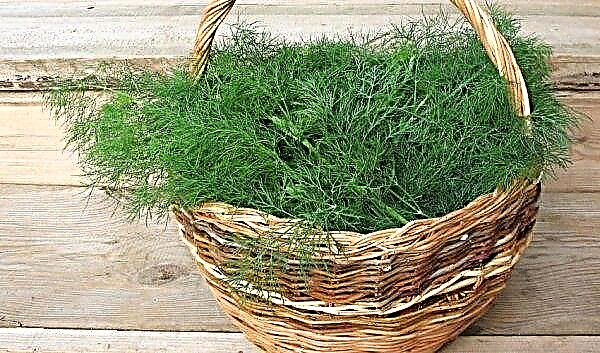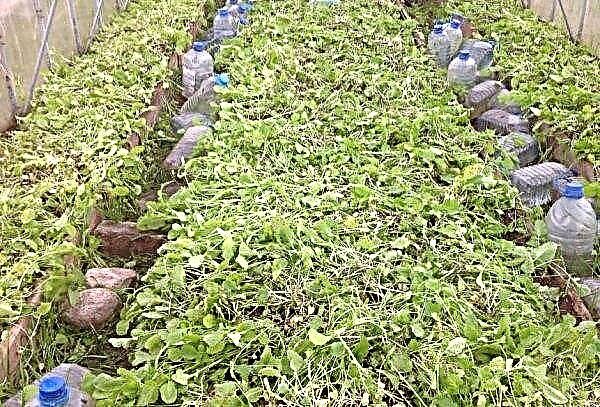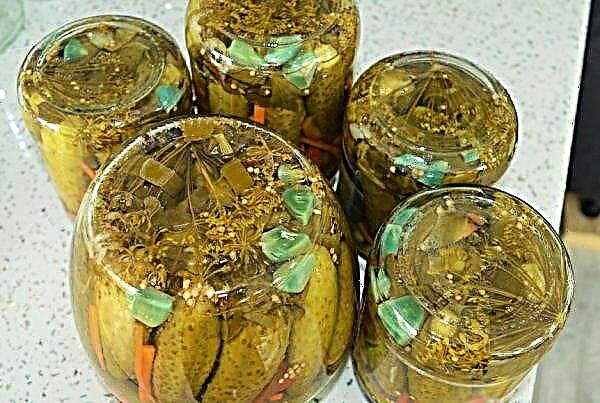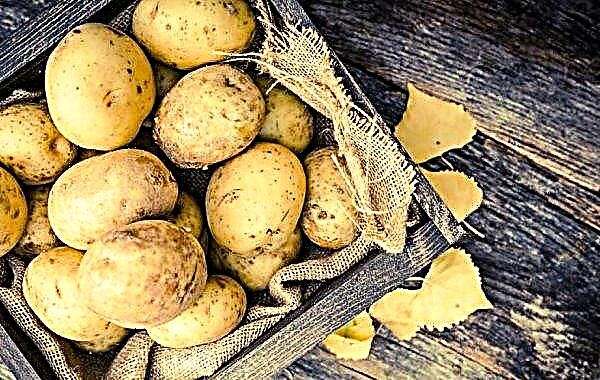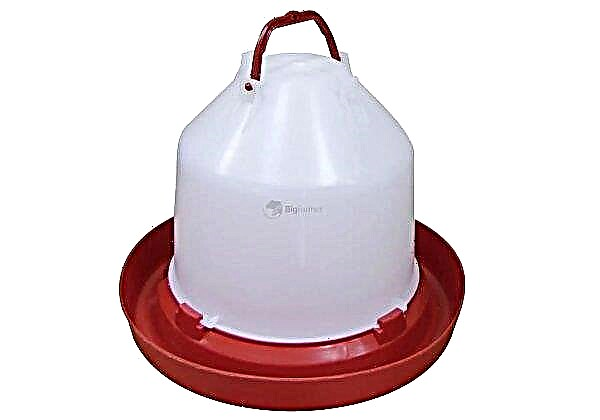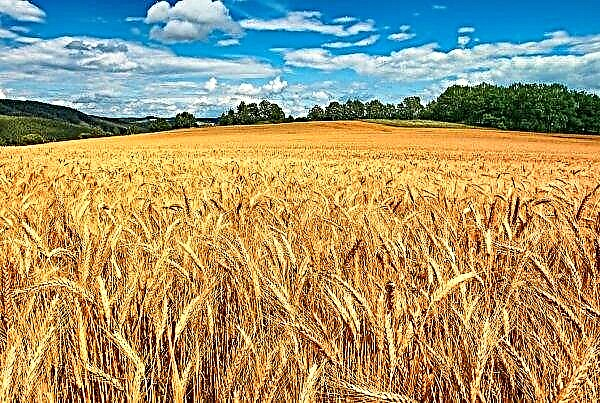Sweet watermelon pulp contains simple sugars and is a high glycemic index (GI) product. Products with increased GI (over 70) should be avoided by diabetics and people who want to lose weight, but watermelon is considered a pleasant exception to the rule. We will find out what GI and composition of a watermelon, how it is useful and how to use it, what are contraindications.
What is the glycemic index of watermelon?
Sugars, which are in the pulp of watermelon, are quickly broken down into glucose in the body, therefore the glycemic index of this berry is quite high - 65–70 units. A well-ripened and accumulated many sugars sweet fruit has it even higher - 75.
Did you know? Not only the product, but also the method of its preparation can influence the level of GI. So, in boiled carrots it is very high (85), and in raw carrots it is much lower (35). Fried potatoes have a GI of 111, and boiled in their uniforms - 65, mashed potatoes - 90.
When eating foods with high glycemic levels in a person’s blood glucose level rises quickly, and the pancreas begins to actively produce insulin. This leads to the accumulation of body fat.
The feeling of fullness quickly disappears and a person very soon wants to eat again. Most high-GI foods are baked goods and sweets, and low-GI foods include cereals and legumes, many vegetables and fruits, dark chocolate, and dairy products.

However, the attitude of nutritionists to watermelon is far from unambiguous. Although it has high GI, a low amount of glucose enters the bloodstream when it is consumed. The glycemic load of the watermelon is small, and all because it is almost 90% composed of water, and there is very little carbohydrate in its pulp.
Chemical and vitamin composition
When compiling your diet, you need to consider not only the GI and glycemic load, but also the composition and calorie content of the product.

Consider in more detail BZHU and nutritional value in 100 g of watermelon pulp:
- proteins - 0.6 g;
- fats - 0.1 g;
- carbohydrates - 5.8 g;
- dietary fiber - 0.4 g;
- water - 92.6 g;
- ash - 0.4 g.
100 g of watermelon pulp contains only 27 kcal, which is a low-calorie product.
Vitamin and mineral composition per 100 grams is visible from the table below:
| Vitamins: | Minerals: |
| Carotene - 0.01 | Sodium - 16 |
| B1 - 0.04 | Potassium - 110 |
| B2 - 0.06 | Calcium - 14 |
| B4 - 4.1 | Phosphorus - 7 |
| B5 - 0.22 | Iron - 1 |
| B6 - 0.09 | Magnesium - 12 |
| B9 - 0.01 | Copper - 0.04 |
| C - 7 | Silicon - 12 |
| E - 0.1 | Sulfur - 6.1 |
| PP - 0.5 | Chlorine - 24.7 |
| Manganese - 0.04 | |
| Zinc - 0.1 |
Useful properties of watermelon
Juicy berry is 90% water. This helps with dehydration. Watermelon has a diuretic and choleretic effect, which allows you to remove toxins and other harmful substances from the body. Therefore, he perfectly "copes" with a severe hangover, contributing to the elimination of alcohol.
Did you know? The vast majority of watermelons are grown in China (63 million tons). Turkey took the second place, with a very wide margin from the Chinese - 3.8 million tons.
And also supports the water-salt balance of a person, removes sand from the kidneys. Fiber and pectin well activate the intestines. The presence of magnesium, potassium, B vitamins and ascorbic acid have a positive effect on the cardiovascular and nervous system.
Folic acid improves memory and activates brain activity. The presence of iron helps with anemia. Citrulline contained in watermelon improves blood circulation, dilates blood vessels, improves potency in men.

The pulp of this berry is useful in case of high acidity, it helps well from heartburn. Watermelon has anti-inflammatory properties and is recommended for consumption in colds as well as infectious diseases. It removes germs, reduces fever. Gargling with watermelon juice reduces inflammation in tonsillitis.
Due to the high content of antioxidants, including lycopene, such a product is a good prophylactic against the appearance of cancer. I use watermelon juice for cosmetic purposes. It perfectly nourishes, tightens, rejuvenates and moisturizes the skin.
Important! Only a high-quality product without an excess of harmful substances will bring benefits. You can check the purchased watermelon for an excess of nitrates in this way - put a piece of pulp in a glass of water. If the liquid in the glass turns bright, then the consumption of such a product should be discarded.
Application features
Watermelon should be eaten separately from other food products. It is recommended to be consumed on an empty stomach or some time after a meal. The watermelon pulp itself is digested quickly, and the consumption of berries with other foods slows down the digestion process. This causes fermentation, which leads to flatulence and, in some cases, upset stomach.
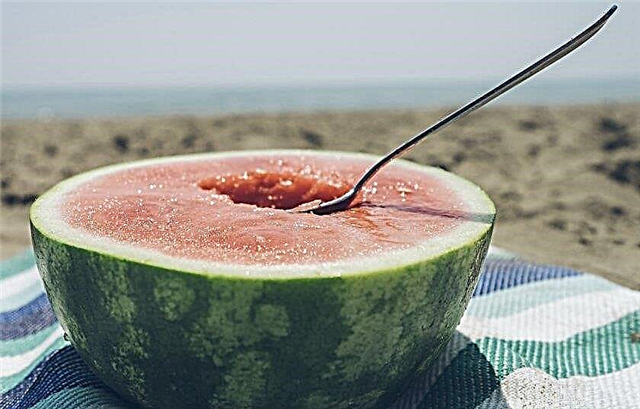
This product is low in calories and is great for losing weight. Those who want to lose weight can replace them with one of the meals. There are watermelon mono-diets that allow you to lose weight. They can be used by people who have no contraindications to the use of this product. They usually take several days and consume 1 kg of pulp per 10 kg of weight.
They do not last for a long time, as nutritionists believe that an adult healthy person can eat no more than 2–2.5 kg of this product per day without harming himself. To combat extra pounds, it is not recommended to drink watermelon juice, since there is practically no fiber in it after a juicer.
The composition of this juicy berry includes simple carbohydrates, so after eating it in a short time there is a feeling of hunger, and especially in people suffering from high blood sugar.
Important! Before you include a new product in your menu, diabetics should consult a doctor.
With type 2 diabetes, you can’t eat more than 100 g of watermelon pulp, at the same time, review the content of carbohydrates in your diet. Type 1 diabetics can consume no more than 300 g of watermelon at a time and not more than 700 g per day. It is strictly forbidden for diabetics to stay on watermelon mono-diets.
Possible contraindications
A frequent harm from this product is that the watermelons that go on sale at the beginning of the summer period often contain a lot of nitrates. This can cause poisoning, because each berry has its own term. A person who has been poisoned by nitrates has diarrhea, vomiting, and nausea.

An increase in body temperature, convulsions, and pain in the joints can also occur. Children under 2 years of age are not given this product. Carefully you need to consume watermelon for nursing mothers, as a child may have an allergic reaction and increased gas formation.
- Watermelon has contraindications:
- Large kidney stones. Watermelon juice helps to remove stones and sand from the kidneys, and large stones can get stuck in the channels.
- Pancreatic disease.
- Bloating.
- Bowel disorder.
- Adhesive processes in the intestines.
- BPH.
- Allergy to this product.
The consumption of watermelon pulp in large quantities can lead to swelling, flatulence, diarrhea. Despite the high glycemic index, watermelon, within reasonable limits, is allowed in the diet of people with diabetes, with its help you can lose extra pounds. Regular consumption of sweet berries can bring a lot of benefits, but we should not forget about the existing contraindications for use and monitor the quality of the acquired fruit.


